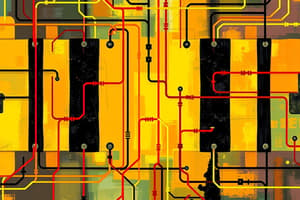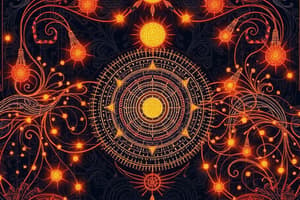Podcast
Questions and Answers
AC circuits only contain resistors.
AC circuits only contain resistors.
False (B)
Power factor is the sine of the angle between voltage and current in an AC circuit.
Power factor is the sine of the angle between voltage and current in an AC circuit.
False (B)
Electrical machines convert electrical energy into mechanical energy or vice versa.
Electrical machines convert electrical energy into mechanical energy or vice versa.
True (A)
Induction motors operate based on electromagnetic induction.
Induction motors operate based on electromagnetic induction.
Transformers operate based on chemical reactions.
Transformers operate based on chemical reactions.
Voltmeters measure current.
Voltmeters measure current.
Diodes allow current flow in both directions.
Diodes allow current flow in both directions.
Logic gates perform basic logical operations.
Logic gates perform basic logical operations.
Electrical earthing protects against electric shock.
Electrical earthing protects against electric shock.
Solar energy is harnessed using wind turbines.
Solar energy is harnessed using wind turbines.
Flashcards
Power Factor
Power Factor
Cosine of the angle between voltage and current in AC circuit.
Resonance
Resonance
Condition in RLC circuit when inductive and capacitive reactances are equal.
Electrical Machines
Electrical Machines
Convert electrical energy into mechanical energy or vice versa.
Transformers
Transformers
Signup and view all the flashcards
Electrical Measuring Instruments
Electrical Measuring Instruments
Signup and view all the flashcards
Diodes
Diodes
Signup and view all the flashcards
Rectifiers
Rectifiers
Signup and view all the flashcards
Logic Gates
Logic Gates
Signup and view all the flashcards
Electrical Earthing
Electrical Earthing
Signup and view all the flashcards
Fuses and Circuit Breakers
Fuses and Circuit Breakers
Signup and view all the flashcards
Study Notes
- AC circuits contain resistors, inductors, and capacitors
- These components affect the voltage and current relationship
- Different types of AC circuits include: R-L, R-C, and R-L-C
- Power factor is the cosine of the angle between voltage and current in an AC circuit
- Resonance is the condition in an RLC circuit when the inductive and capacitive reactances are equal
- Polyphase systems are used for power transmission and distribution
- Common polyphase systems include three-phase systems
- Three-phase systems can be connected in star or delta configurations
- The type of wiring used depends on the application - single-phase, three-phase
- Electrical machines convert electrical energy into mechanical energy or vice versa
- Types of AC motors include induction motors and synchronous motors
- Induction motors operate based on electromagnetic induction
- Synchronous motors operate at a constant speed determined by the supply frequency
- Types of DC motors include series, shunt, and compound motors
- DC motors have different characteristics in terms of torque and speed regulation
- Armature reaction affects the performance of DC machines
- Commutation is the process of reversing the current in the armature coils of a DC machine
- Transformers transfer electrical energy from one circuit to another
- Transformers operate based on electromagnetic induction
- Transformers consist of primary and secondary windings
- The transformer ratio determines the voltage and current transformation
- Transformer losses include core losses and copper losses
- Auto-transformers have a single winding that acts as both primary and secondary
- Electrical measuring instruments measure electrical quantities
- Types of instruments include ammeters, voltmeters, wattmeters, and energy meters
- Ammeters measure current
- Voltmeters measure voltage
- Wattmeters measure power
- Energy meters measure electrical energy consumption
- Instrument transformers extend the range of AC instruments
- Digital instruments provide a digital display of measured values
- Transducers convert physical quantities into electrical signals
- Types of transducers include resistance, inductance, and capacitance transducers
- Common electronic components include diodes, transistors, and thyristors
- Diodes allow current flow in one direction only
- Transistors amplify or switch electronic signals
- Thyristors are used for controlling high-power circuits
- Rectifiers convert AC voltage into DC voltage
- Filters smooth the output voltage of rectifiers
- Inverters convert DC voltage into AC voltage
- Choppers convert DC voltage from one level to another
- Oscillators generate AC signals
- Amplifiers increase the amplitude of electronic signals
- Different types of amplifiers include voltage amplifiers and power amplifiers
- Operational amplifiers (op-amps) are versatile analog circuit building blocks
- Digital electronics deals with digital signals
- Logic gates perform basic logical operations
- Common logic gates include AND, OR, NOT, NAND, and NOR gates
- Logic gates are used to build digital circuits
- Combinational circuits produce outputs based on the current inputs
- Sequential circuits produce outputs based on current and past inputs
- Flip-flops are basic memory elements
- Counters count the number of pulses
- Registers store binary information
- Microcontrollers are integrated circuits that can be programmed to perform specific tasks
- Microcontrollers consist of a processor, memory, and input/output peripherals
- Programming languages are used to write instructions for microcontrollers
- Electrical power generation involves converting various forms of energy into electrical energy
- Power plants use different energy sources such as coal, gas, hydro, and nuclear
- Power transmission transfers electrical power from generating stations to distribution centers
- Transmission lines carry high-voltage power over long distances
- Substations transform voltage levels and provide switching capabilities
- Power distribution delivers electrical power to consumers
- Distribution networks consist of feeders, distributors, and service mains
- Types of wiring include: Casing & Capping, Conduit, Cleat
- Electrical earthing protects against electric shock
- Earthing provides a low-resistance path for fault currents
- Different earthing methods include plate earthing and pipe earthing
- Earth resistance should be low to ensure effective protection
- Electrical safety is essential to prevent accidents
- Safety measures include insulation, grounding, and circuit protection
- Fuses and circuit breakers protect against overloads and short circuits
- Residual current devices (RCDs) protect against earth leakage currents
- First aid should be administered to victims of electric shock
- Knowledge of safety regulations and standards is important for electricians
- Conventional and Non-conventional energy generation methods
- Solar energy is harnessed using photovoltaic cells
- Wind energy is harnessed using wind turbines
- Renewable energy sources are sustainable and environmentally friendly
- Electrical estimation involves calculating the quantity of materials required for a job
- Costing involves determining the cost of materials, labor, and other expenses
- Estimation and costing are important for preparing accurate project budgets
- Maintenance of electrical equipment ensures reliable operation
- Types of maintenance include preventive maintenance and breakdown maintenance
- Preventive maintenance involves regular inspections and servicing
- Breakdown maintenance involves repairing equipment after a failure
- Troubleshooting involves identifying and solving problems in electrical circuits and equipment
- Testing and commissioning are performed to verify the performance of electrical systems
- Different tests are conducted to ensure safety and functionality
- Commissioning involves putting the system into operation
- Electric traction is the use of electric power for transportation
- Traction motors drive electric vehicles
- Control systems regulate the speed and torque of traction motors
- Different types of electric traction systems exist, including DC and AC systems
- Elevators and lifts use electric motors to move vertically
- Control systems ensure safe and efficient operation
- Safety devices are incorporated to prevent accidents
- Welding is a process of joining metals using heat
- Electric arc welding uses an electric arc to generate heat
- Different welding techniques include shielded metal arc welding (SMAW) and gas metal arc welding (GMAW)
- Safety precautions must be taken to prevent burns, electric shock, and exposure to fumes
- Air conditioning maintains comfortable temperature and humidity levels
- Refrigeration cycles are used to cool air
- Air conditioning systems consist of compressors, condensers, evaporators, and expansion valves
- Electrical controls regulate the operation of air conditioning systems
- The Indian Electricity Rules provide guidelines for electrical installations and safety
- Knowledge of the IE Rules is essential for electricians
- The rules cover various aspects of electrical work, including wiring, earthing, and protection
Studying That Suits You
Use AI to generate personalized quizzes and flashcards to suit your learning preferences.




